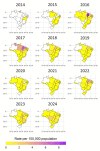Epidemiology of Chikungunya Hospitalizations, Brazil, 2014-2024
- PMID: 40763201
- PMCID: PMC12407205
- DOI: 10.3201/eid3109.250554
Epidemiology of Chikungunya Hospitalizations, Brazil, 2014-2024
Abstract
We describe 7,421 chikungunya hospitalizations in Brazil covered by the country's unified health system during 2014-2024. Most (43.2%) hospitalizations occurred in 2016 and 2017, reaching 0.72 (95% CI 0.69-0.76) hospitalizations/100,000 population in 2016. Hospitalizations were more frequent among persons who were female (55.8%), identifying as brown or black (63.5%), and 1-19 years of age (31.4%). Intensive care unit admissions occurred in 1.4% of cases, predominantly among children <5 and adults >85 years of age. The overall in-hospital case-fatality rate was 1.1%, which increased substantially with age, reaching 11.5% among patients >90 years of age and 14.1% among men 85-89 years of age. Patients admitted to the intensive care unit had a case-fatality rate of 21.1%. The total cost of chikungunya hospitalizations was US $560,746 (US $76.26 per patient). Our findings provide insights for surveillance of the most severe chikungunya cases.
Keywords: Brazil; Chikungunya virus; chikungunya fever; hospitalization; vector-borne infections; viruses; zoonoses.
Figures



References
-
- World Health Organization. Chikungunya [cited 2025 Mar 23]. https://www.who.int/news-room/fact-sheets/detail/chikungunya
-
- Brazil Ministry of Health. Chikungunya fever—notifications recorded in the Notifiable Diseases Information System [in Portuguese] [cited 2025 Mar 23]. http://tabnet.datasus.gov.br/cgi/tabcgi.exe?sinannet/cnv/chikunbr.def
Publication types
MeSH terms
LinkOut - more resources
Full Text Sources
Medical

